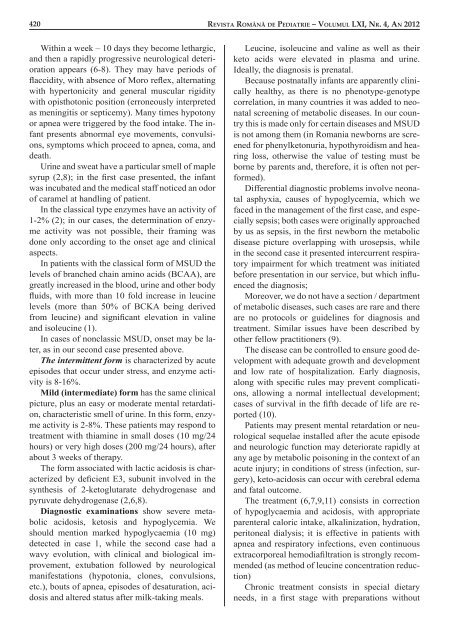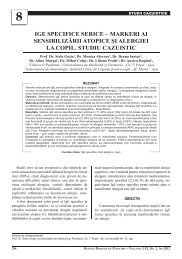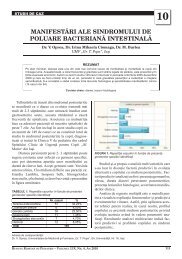Cristina Oana Marginean, Carmen Duicu, Claudia ... - Pediatrie
Cristina Oana Marginean, Carmen Duicu, Claudia ... - Pediatrie
Cristina Oana Marginean, Carmen Duicu, Claudia ... - Pediatrie
You also want an ePaper? Increase the reach of your titles
YUMPU automatically turns print PDFs into web optimized ePapers that Google loves.
420<br />
Within a week – 10 days they become lethargic,<br />
and then a rapidly progressive neurological deterioration<br />
appears (6-8). They may have periods of<br />
fl accidity, with absence of Moro refl ex, alternating<br />
with hypertonicity and general muscular rigidity<br />
with opisthotonic position (erroneously interpreted<br />
as meningitis or septicemy). Many times hypotony<br />
or apnea were triggered by the food intake. The infant<br />
presents abnormal eye movements, convulsions,<br />
symptoms which proceed to apnea, coma, and<br />
death.<br />
Urine and sweat have a particular smell of maple<br />
syrup (2,8); in the fi rst case presented, the infant<br />
was incubated and the medical staff noticed an odor<br />
of caramel at handling of patient.<br />
In the classical type enzymes have an activity of<br />
1-2% (2); in our cases, the determination of enzyme<br />
activity was not possible, their framing was<br />
done only according to the onset age and clinical<br />
aspects.<br />
In patients with the classical form of MSUD the<br />
levels of branched chain amino acids (BCAA), are<br />
greatly increased in the blood, urine and other body<br />
fluids, with more than 10 fold increase in leucine<br />
levels (more than 50% of BCKA being derived<br />
from leucine) and significant elevation in valine<br />
and isoleucine (1).<br />
In cases of nonclassic MSUD, onset may be later,<br />
as in our second case presented above.<br />
The intermittent form is characterized by acute<br />
episodes that occur under stress, and enzyme activity<br />
is 8-16%.<br />
Mild (intermediate) form has the same clinical<br />
picture, plus an easy or moderate mental retardation,<br />
characteristic smell of urine. In this form, enzyme<br />
activity is 2-8%. These patients may respond to<br />
treatment with thiamine in small doses (10 mg/24<br />
hours) or very high doses (200 mg/24 hours), after<br />
about 3 weeks of therapy.<br />
The form associated with lactic acidosis is characterized<br />
by defi cient E3, subunit involved in the<br />
synthesis of 2-ketoglutarate dehydrogenase and<br />
pyruvate dehydrogenase (2,6,8).<br />
Diagnostic examinations show severe metabolic<br />
acidosis, ketosis and hypoglycemia. We<br />
should mention marked hypoglycaemia (10 mg)<br />
detected in case 1, while the second case had a<br />
wavy evolution, with clinical and biological improvement,<br />
extubation followed by neurological<br />
manifestations (hypotonia, clones, convulsions,<br />
etc.), bouts of apnea, episodes of desaturation, acidosis<br />
and altered status after milk-taking meals.<br />
REVISTA ROMÂNÅ DE PEDIATRIE – VOLUMUL LXI, NR. 4, AN 2012<br />
Leucine, isoleucine and valine as well as their<br />
keto acids were elevated in plasma and urine.<br />
Ideally, the diagnosis is prenatal.<br />
Because postnatally infants are apparently clinically<br />
healthy, as there is no phenotype-genotype<br />
correlation, in many countries it was added to neonatal<br />
screening of metabolic diseases. In our country<br />
this is made only for certain diseases and MSUD<br />
is not among them (in Romania newborns are screened<br />
for phenylketonuria, hypothyroidism and hearing<br />
loss, otherwise the value of testing must be<br />
borne by parents and, therefore, it is often not performed).<br />
Differential diagnostic problems involve neonatal<br />
asphyxia, causes of hypoglycemia, which we<br />
faced in the management of the fi rst case, and especially<br />
sepsis; both cases were originally approached<br />
by us as sepsis, in the fi rst newborn the metabolic<br />
disease picture overlapping with urosepsis, while<br />
in the second case it presented intercurrent respiratory<br />
impairment for which treatment was initiated<br />
before presentation in our service, but which infl uenced<br />
the diagnosis;<br />
Moreover, we do not have a section / department<br />
of metabolic diseases, such cases are rare and there<br />
are no protocols or guidelines for diagnosis and<br />
treatment. Similar issues have been described by<br />
other fellow practitioners (9).<br />
The disease can be controlled to ensure good development<br />
with adequate growth and development<br />
and low rate of hospitalization. Early diagnosis,<br />
along with specifi c rules may prevent complications,<br />
allowing a normal intellectual development;<br />
cases of survival in the fi fth decade of life are reported<br />
(10).<br />
Patients may present mental retardation or neurological<br />
sequelae installed after the acute episode<br />
and neurologic function may deteriorate rapidly at<br />
any age by metabolic poisoning in the context of an<br />
acute injury; in conditions of stress (infection, surgery),<br />
keto-acidosis can occur with cerebral edema<br />
and fatal outcome.<br />
The treatment (6,7,9,11) consists in correction<br />
of hypoglycaemia and acidosis, with appropriate<br />
parenteral caloric intake, alkalinization, hydration,<br />
peritoneal dialysis; it is effective in patients with<br />
apnea and respiratory infections, even continuous<br />
extracorporeal hemodiafi ltration is strongly recommended<br />
(as method of leucine concentration reduction)<br />
Chronic treatment consists in special dietary<br />
needs, in a fi rst stage with preparations without




